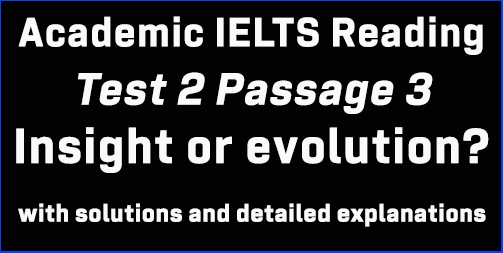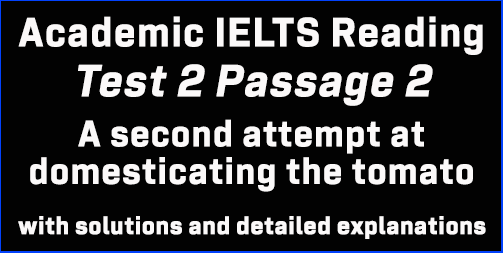IELTS Academic Reading: Cambridge 4 Test 4 Reading passage 3; IN SEARCH OF THE HOLY GRAIL; with best solutions and best explanations
This Academic IELTS Reading post focuses on solutions to IELTS Cambridge 4 Reading Test 4 Reading Passage 3 which is titled ‘IN SEARCH OF THE HOLY GRAIL’. This is a targeted post for IELTS candidates who have big problems finding out and understanding Reading Answers in the AC module. This post can guide you the best to understand every Reading answer without much trouble. Finding out IELTS Reading answers is a steady process, and this post will assist you in this respect.
IELTS Cambridge 4 Test 4: AC Reading Module
Reading Passage 3: Questions 27-40
The title of the passage: IN SEARCH OF THE HOLY GRAIL
Questions 27-32: Completing sentences with NO MORE THAN THREE WORDS OR A NUMBER
In this type of question, candidates are asked to write maximum of three words or a number to complete sentences on the given topic. For this type of question, first, skim the passage to find the keywords in the paragraph concerned with the answer, and then scan to find the exact word.
[TIPS: Here scanning technique will come in handy. Target the keywords of the questions to find the answers. Remember to focus on Proper nouns, random Capital letters, numbers, special characters of text etc.]
Question no. 27: The passage compares the Project in scale to the ________.
Keywords for the question: passage, compares, the Project, in scale,
In paragraph no. 1, lines 1-7 say, “It has been called the Holy Grail of modern biology. Costing more than £2 billion, it is the most ambitious scientific project since the Apollo programme that landed a man on the moon. . . …. ..”
Here, it is the most ambitious scientific project since = compares the Project in scale to,
So, the answer is: Apollo programme
Question no. 28: The possible completion date of the Project is ________.
Keywords for the question: possible completion date,
In paragraph no. 1, lines 8-12 say, “ .. .. .. And it will take longer to accomplish than the lunar missions, for it will not be complete until early next century. .. … .”
Here, it will not be complete until = possible completion,
So, the answer is: (early) next century
Question no. 29: To write out the human genome on paper would require ________ books.
Keywords for the question: write out, human genome, on paper, require, books,
In paragraph no. 3, lines 16-20 say, “It is an extremely long text, for the human genome contains more than 3 billion letters: On the printed page it would fill about 7,000 volumes. . .. .”
Here, On the printed page it would fill = To write out the human genome on paper would require, volumes = books,
So, the answer is: 7,000
Question no. 30: A genetic problem cannot be treated with drugs because strictly speaking it is not a __________.
Keywords for the question: a genetic problem, cannot be treated, with drugs, because, it is not,
At the beginning of paragraph no. 5, the writer says, “None of the single-gene disorders is a disease in the conventional sense, for which it would be possible to administer a curative drug: . . .. .”
Here, single-gene disorders = genetic problem, none = not,
So, the answer is: disease
Question no. 31: Research into genetic defects had its first success in the discovery of the cause of one form of __________.
Keywords for the question: research, genetic defects, first success, discovery, cause of, one form of,
Again, in paragraph no. 5, lines 9-13 say, “ . .. . . In 1986, American researchers identified the genetic defect underlying one type of muscular dystrophy. . . … .”
Here, identified = first success in the discovery, genetic defect underlying one type of = the cause of one form of,
So, the answer is: muscular dystrophy
Question no. 32: The second success of research into genetic defects was to find the cause of __________.
Keywords for the question: second success, research into genetic defects, find, cause of,
In paragraph no. 5, lines 13-19 say, “ . .. . . In 1989, a team of American and Canadian biologists announced that they had found the site of the gene which, when defective, gives rise to cystic fibrosis. .. .. .. .”
Here, In 1989, a team of American and Canadian biologists announced = The second success of research, gene . .. . . when defective = genetic defects,
So, the answer is: cystic fibrosis
Questions 33-40: Classifying groups
[This type of question asks candidates to classify information from the given reading text. Candidates are given some groups from the text, and a list of options, which are listed as A, B, C, D etc. They must match the correct groups with the correct options.
N.B.: This question type doesn’t follow any sequence. So, they should be answered after all other questions in the passage.]
Question no. 33: The Project will provide a new understanding of major diseases.
Keywords for the question: the Project, will provide, new understanding, major diseases,
In the first paragraph, the writer says, “ . .. .. Even before it is finished, according to those involved, this project should open up new understanding of, and new treatments for, many of the ailments that afflict humanity. As a result of the Human Genome Project, there will be new hope of liberation from the shadows of cancer, heart disease, autoimmune diseases such as rheumatoid arthritis, and some psychiatric illnesses.”
Here, new understanding of, and new treatments for, many of the ailments = new understanding of major diseases, there will be new hope = long-term hopes for the Project,
So, the answer is: D (the writer’s reporting of the long-term hopes for the Project)
Question no. 34: All the components which make up DNA are to be recorded and studied.
Keywords for the question: all the components, make up DNA, to be recorded and studied,
The writer says at the end of paragraph no. 3, “ . .. . . Yet, within little more than a decade, the position of every letter and its relation to its neighbours will have been tracked down, analysed and recorded.”
Here, the position of every letter and its relation to its neighbours = All the components which make up DNA,
will have been tracked down, analysed and recorded = are to be recorded and studied,
So, the answer is: C (the writer’s reporting of facts about the Project)
Question no. 35: Genetic monsters may be created.
Keywords for the question: genetic monsters, may be created,
At the end of paragraph no. 2, the writer says, “ . .. .. But others see the future through a darker glass, and fear that the project may open the door to a world peopled by Frankenstein’s monsters and disfigured by a new eugenics.”
Here, others see the future through a darker glass, and fear = other people’s fear, may open the door to a world peopled by Frankenstein’s monsters and disfigured by a new eugenics = Genetic monsters may be created,
So, the answer is: B (other people’s fears about the Project reported by the writer)
Question no. 36: The correct order and inter-relation of all genetic data in all DNA will be mapped.
Keywords for the question: correct order, inter-relation, all genetic data, all DNA, will be mapped,
The final lines of paragraph no. 6 say, “ . .. . . Momentum quickly built up behind the Human Genome Project and its objective of ‘sequencing’ the entire genome – writing out all the letters in their correct order.”
Here, writing out all the letters in their correct order = The correct order and inter-relation of all genetic data in all DNA,
So, the answer is: C (the writer’s reporting of facts about the Project)
Question no. 37: Parents will no longer worry about giving birth to defective offspring.
Keywords for the question: parents, will no longer worry, giving birth, defective offspring,
The final lines of paragraph no. 5 give the answer, “ . .. . At the least, these scientific advances may offer a way of screening parents who might be at risk of transmitting a single-gene defect to any children that they conceive. Foetuses can be tested while in the womb, and if found free of the genetic defect, the parents will be relieved of worry and stress, knowing that they will be delivered of a baby free from the disorder.”
Here, the parents will be relieved of worry and stress, knowing that they will be delivered of a baby free from the disorder = Parents will no longer worry about giving birth to defective offspring,
these scientific advances may offer a way = the writer’s reporting of the long-term hopes,
So, the answer is: D (the writer’s reporting of the long-term hopes for the Project)
Question no. 38: Being ‘human’ may be defined solely in terms of describable physical data.
Keywords for the question: being ‘human’, may be defined, solely, describable physical data,
Take a look at these lines from paragraph no. 6, “In the mid-1980s, the idea gained currency within the scientific world that the techniques which were successfully deciphering disorder-related genes could be applied to a larger project: if science can learn the genetic spelling of cystic fibrosis, why not attempt to find out how to spell ‘human’? .. . . .”
Here, the idea gained currency within the scientific world = other people’s fears about the Project, why not attempt to find out how to spell ‘human’ = Being ‘human’ may be defined solely in terms of describable physical data,
So, the answer is: B (other people’s fears about the Project reported by the writer)
Question no. 39: People may be discriminated against in new ways.
Keywords for the question: people, may be discriminated, new ways,
In the beginning of paragraph no. 8, take a look at these lines, “ . .. . . But if the new knowledge is not used wisely, it also holds the threat of creating new forms of discrimination and new methods of oppression. . .. .”
Here, it also holds the threat = the writer’s fears, creating new forms of discrimination and new methods of oppression = People may be discriminated against in new ways,
So, the answer is: A (the writer’s fears about the Human Genome Project)
Question no. 40: From past experience humans may not use this new knowledge wisely.
Keywords for the question: past experience, humans, may not use, new knowledge, wisely,
The final lines of the final paragraph say, “ .. . .. But there is the central moral problem: how can we ensure that when we choose, we choose correctly? That such a potential is a promise and not a threat? We need only look at the past to understand the danger.”
Here, there is the central moral problem = the writer’s fears, We need only look at the past to understand the danger = From past experience humans may not use this new knowledge wisely,
So, the answer is: A (the writer’s fears about the Human Genome Project)
Click here for solutions to Cambridge 2 AC Test 4 Reading Passage 1
Click here for solutions to Cambridge 2 AC Test 4 Reading Passage 2




2 thoughts on “IELTS Academic Reading: Cambridge 4 Test 4 Reading passage 3; IN SEARCH OF THE HOLY GRAIL; with best solutions and best explanations”